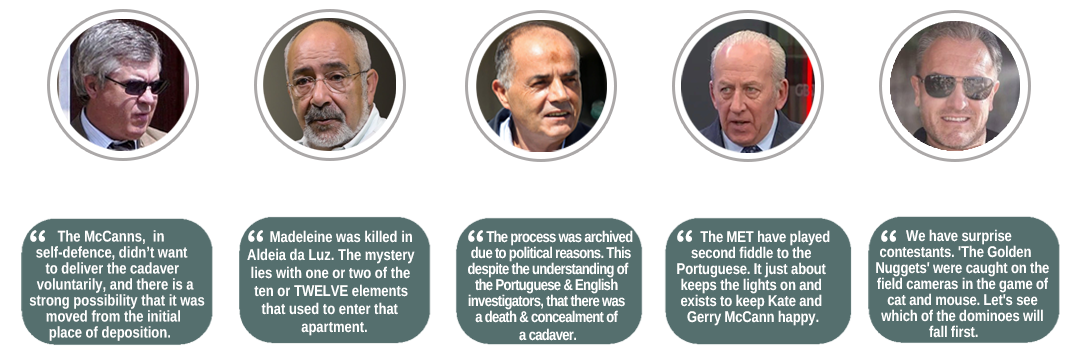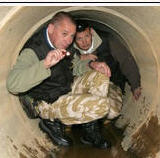MURDER OF LEE BALKWELL - New article by Michael Gillard, top crime author and writer (13 Sep 2021)
The Complete Mystery of Madeleine McCann™ :: Other Crimes and Mysteries :: Truth and justice for murdered Stuart Lubbock and Lee Balkwell
Page 1 of 1 • Share
 MURDER OF LEE BALKWELL - New article by Michael Gillard, top crime author and writer (13 Sep 2021)
MURDER OF LEE BALKWELL - New article by Michael Gillard, top crime author and writer (13 Sep 2021)
THE CEMENT MIXER 'MURDER'
by Michael Gillard
"A Mangled Body: A Crime Family and Institutionally Corrupt Policing in Essex"/i]
[i]Warning: There are images from the crime scene in this copyrighted article that may be upsetting
Evidence of institutional police corruption will feature in a legal bid to have a notorious cold case linked to organised crime investigated for the first time as a murder.
The High Court has granted permission for the family of Lee Balkwell to challenge an “unreasonable and irrational” decision by Essex police to close the book on his suspicious death 19 years ago.
The 33-year-old was found in the early hours of 18 July 2002 wedged between the chassis and drum of a cement mixer lorry that he drove for a businessman involved in drug trafficking and gun running.
The businessman maintains the death was a freak accident that occurred while the two men were cleaning out the drum at one in the morning on a remote farm.
Essex police has done everything to frustrate the family’s relentless efforts to expose spectacular failings in how the case was investigated.
Chasing down leads about corrupt cops put members of the Balkwell family on a collision course not just with the police establishment but also the Essex underworld.
They’ve been threatened, followed, insulted and, in the case of grieving father Les Balkwell, had his life endangered when the police tried to recruit him as an informant against organised crime.
However, for the last six years, the family has been assisted by a team of retired detectives, leading forensic scientists and a human rights judge whose efforts have been documented by "The Upsetter".
.
The team believe the evidence shows that Lee Balkwell was murdered and the crime scene ‘staged’ to look like an accident.
Their first success came in 2016 when a court forced Essex police to pay damages for the failure to investigate properly.
One disclosed internal email revealed that a secret order had come down from the top of the force to ignore a direction by the police watchdog that the death should be investigated as a murder.
The watchdog had found the initial investigation was “severely flawed” but did not think corruption played a part.
The family and its team of experts, however, do not accept that the litany of police failures can be explained away by incompetence alone and question the independence of the watchdog.
Soon after Lee’s death, a police whistleblower came forward to describe how Essex organised crime and freemasonry had infiltrated the local force and sections of the Metropolitan police.
The concealment and denial of police failings over the last nineteen years and a concern for image over a duty of candour to the Balkwell family firmly meets the definition of ‘institutional corruption’ recently developed by a Home Office appointed panel that looked into the unsolved murder of Daniel Morgan.
In July, the High Court dismissed Essex police’s arguments opposing a judicial review and agreed to a full hearing on why the Balkwell case should now be investigated as a homicide.
If successful at the full hearing, which is not expected until next year, the family will ask that Essex police step aside and allow an independent outside force to conduct a full murder investigation.
Here’s why.
"Woof! He's Dead"
It was shaping up to be a hot day in Essex. At around 7am, Lee Balkwell kissed goodbye to Lorraine, his girlfriend of the last six years, and headed off on his run delivering mixed cement for Upminster Concrete.
The couple had a five month-old baby boy and a new house to maintain on Lee’s salary. Simon Bromley, his on and off boss of the last six months, operated a concrete business from Baldwins Farm, a remote part of the Essex countryside where he lived with his extended family in separate bungalows.
Lee would arrive early, fill the lorry’s drum with a mix of gravel and sand which rotated while he drove to whoever had placed the order. At the end of the day, he’d return to the farm, hose out the drum, change clothes and head back in his own car to his new family.
On 17 July, 2002, the last full day of his life, Lee called Lorraine throughout the afternoon with updates on when he would be knocking off.
At 4pm he told her the drum had broken. A few hours later he called to say Bromley was helping him remove dried cement stuck to the drum before it got dark and she should eat alone.
Gunning out dried cement is a messy business and involves getting inside the drum and breaking up the cement using a specialised tool - the Kango hammer.
Lee called to say he was still at it when the TV credits rolled on Big Brother at 10.30pm. An hour later he told Lorraine he was hungry and desperate for a bath. And at 11.44pm, just before turning in, she called Lee with one more dirty job - to sort out the soiled cat litter tray when he came home. He never did.
For some reason, Lee returned to Baldwins Farm at just past midnight, having left to get a quick bite at a Chinese takeaway. One hour later, specifically at 1.03am, David Bromley, Simon’s father, called 999 and put his panicked son on the phone:
“We was gunning the back of a ready mix lorry out … I’ve had to try and move it around a bit and he’s gone to get out of the hole as I’ve started the lorry up and the handle had moved forward and he fucking got caught under the lorry … The lever at the back must have moved forward a bit or something … He’s dead. He was just lying there, lifeless mate, the lorry just went round … The way it happened, it’s just … WOOF! He’s dead.”
Ambulance crews arrived within twenty minutes, followed by the fire brigade, who would have the tricky task of removing Lee’s smashed frame when the sun rose.
“My first impression was that the scene was suspicious. The main reason was that there were no lights. I was talking to the fireman after they arrived and a few of them felt it was a bit suspicious,” recalled experienced paramedic Tricia Tippett in her statement to the police. How could they be cleaning out the cement lorry so late at night and in “pitch black”, she wondered.
Tippett was also struck by the position of Lee’s arm, shoulder and head. He was a “large man … trapped in a very small gap and I was confused as to how he could have got into a gap so small.”
Essex police were the last emergency service to arrive at Baldwins Farm, whose owners were well known. Officers came in numbers, including senior detectives, but with a mindset that it was an accident.
Suspicious Minds
Like clockwork every day more or less for the last nineteen years, Les Balkwell and his wife Jackie wake up at 4.45am.
Les usually feels nauseous as the seconds tick by brushing his teeth while thinking on the time he learned his first-born son was dead. It was Tanya, his youngest, who brought the news at 4.45am then collapsed in to her dad’s arms.
Although he didn’t let on outside his immediate family, Les was suspicious almost from the get go. For the first few days, he and Jackie struggled to get out of bed. But it was important the police family liaison officer believed the Balkwells harboured no bad feeling nor blame towards the Bromleys.
That was the way Les had been brought up in east London - not to educate the old bill. His parents had run a pub in Canning Town where just a bar separated hard living, light fingered dockers and career villains from the local detectives.
Les and Jackie married in 1968. They lived above the Tidal Basin Tavern until the early Seventies when they joined the white flight moving to places like Rainham in Essex to raise their own family. After Lee came Les junior followed by Tanya. What they lacked in height, they all made up in personality.
By all accounts, Lee was a popular boy at school. He was good at sports - football and golf - and later with the ladies. He had the chat, liked a pint, maybe the odd toot on a night out, but nothing too lairy. He wasn’t violent, but could hold his hands up if backed into a corner.
Over 500 people came to the funeral in September, says Les. “There were so many flowers they needed a separate hearse.”
By now, words had been exchanged with Simon Bromley. Les didn’t think his explanation added up and had told him so.
For starters, Lee was a good operator of cement mixers. He had developed a routine after getting grease all over his dad’s sofa and dirt on the carpet. From then on, as soon as he finished work Lee went to his car to put on a fleece and trainers to replace his dirty boots.
So Les was surprised to learn his son had died wearing a blue fleece while cleaning out the drum on a hot July night and that his boots had no grit in the deep grooves of the soles.
But to keep up the pretence, Simon Bromley and his father David were allowed to attend the funeral, much to the annoyance of some other members of the Balkwell family.
The Bromleys had brought a wreath that said, ‘God Bless you Lennie’. It was Lee’s nickname because in his youth he’d sported a wet perm like the faded northern TV comedian Lennie Bennett.
Among the mourners were some real Canning Town ‘faces’. Terrible business, they whispered. Les won’t let it go. Some noses are gonna get put right outta joint. Jackie knew it too. She wouldn’t stand in his way, she told her husband. “But none of this will bring my Lee back.”
Les feels blessed to still have her by his side.
“We’ve had a lot of compliments that we haven’t split up, because people in our position usually do. She’s blinding. If [Jackie] hadn’t been how she is, understanding me, I wouldn’t have survived.”
There’s another group Les thanks for being here today: Those Canning Town faces who let the word out they were in his corner. Men who came up in the era before the cocaine cowboys and steroid freaks took over the Essex underworld. Men who still commanded respect from the new players in the drug game, where getting high on your own supply was as common as paranoia, rip offs, corruption and grasses.
Belt and Braces
The belt holding up Lee’s jeans on the night he died would become a cipher for forensic science and for those who believed the dead can speak.
Lorraine Mitchinson, Lee’s distraught girlfriend, had initially told the police that she wanted his clothes. The day after the death, the police family liaison officer recorded that Lorraine had changed her mind and only wanted his belt, keys, wallet and phone.
Within 24 hours of the post mortem, the police destroyed the rest of Lee’s clothing - a remarkable decision the detective in charge, superintendent Graeme Bull, took because, in his view, the death was not suspicious.
Les, however, was coming to an alternative view; that his son could not have died where he was found but must have been dragged, lifted by his belt and wedged between the drum and chassis.
This theory would explain some of the marks on Lee’s back that the Coroner’s office had mentioned to the family when they went to the mortuary.
The belt had been washed when the police returned it to Lorraine. She gave it to Les unaware of its destination.
A clairvoyant fondled the black leather and buckle while Jackie and Tanya briefed her. Then, Quincy-like, the mystic announced that Lee was beaten and dragged to the lorry and his murder made to look like an accident.
To the non-bereaved this was mumbo jumbo, but for Tanya and her mum, who was really struggling to cope, it had a calming effect, said Les.
When he returned the belt, Les got a mouthful from Lorraine’s parents. They were concerned that he was not letting the police do their job and running round like an amateur Colombo. Why can’t you just accept it was an accident and stop coming over with your theories, they told him.
No one was going to convince Les it could have happened the way Bromley and now the police were saying. He knew concrete mixers. He’d driven them when he ran a haulage business after losing his job as a car toolmaker for Ford.
The lorry mixer Lee drove had two inspection hatches on either side of the drum. The 16 by 21 inch gap is used to see how the cement is mixing and can, in some circumstances, be used to clean out the drum when stationary.
According to Bromley’s early accounts, Lee was either inside the drum and tossed out or getting out when it started moving. Given where Lee ended up, that meant he was attempting to exit via the hatch feet first and face down when the sudden rotation crushed his head and shoulders between the drum and the chassis.
Initially, when the police formally interviewed Bromley in August 2002, the officer explained they were investigating a “tragic accident”. It wasn’t until eight years later that Essex police accepted there were problems with what Bromley was saying. A police report found:
“There are three major inconsistencies between the accounts given by Simon Bromley, these centre on the situation Lee Balkwell was in when Bromley started the vehicle engine.”
The first inconsistency was whether Lee was inside the drum, trying to get out or outside when Bromley turned on the engine and the drum started rotating.
The second inconsistency was what Bromley said about the movement of the drum and the number of rotations that killed Lee. And thirdly, what he actually saw of the incident.
The police report said:
“It appears that only Simon Bromley knows for sure and he’s not given a consistent explanation, for whatever reason.”
What is not in dispute is that soon after Lee’s death Bromley offered to pay £30,000 to Lorraine. According to a friend of Bromley this was done with good intent.
“After Lee died Simon Bromley felt obliged to pay compensation to Lorraine. Simon paid £30,000 so she could pay the mortgage,” Glen Nicholls told the police in a statement. He had acted as an intermediary during tense negotiations between the Bromleys, Balkwells and Mitchinsons within weeks of the death.
The bank was threatening repossession of Lorraine’s home and the police were recommending that she make a claim on Upminster Concrete’s personal liability insurance. Nicholls brokered a deal whereby if the insurance claim was successful, which it was, Lorraine would pay back the £30,000.
According to Les, Simon Bromley had originally offered £50,000 but his father ended up handing over a £30,000 cheque for Lorraine.
It didn’t matter much. Les wanted nothing to do with the payment. By the end of 2002 he was at war with the Bromleys and no longer hid his suspicions, which now included the belief that Essex police were part of the problem.
Dirty Cops?
Baldwins Farm was known to the police well before the death of Lee Balkwell. The Bromleys had hosted Acid House raves in the nineties and officers had been to the farm to arrest Simon Bromley’s mum, Linda, for drug offences. His father also loved cocaine.
On the night Lee died, one of the first on the scene was duty inspector Richard Croft, who after speaking to Simon Bromley came to the conclusion that Lee’s death was a case of corporate manslaughter, not murder.
Over the following months, Les called Croft to vent his concerns that “Essex police are bent.” Croft reported these calls to the force’s professional standards department (PSD) - the anti-corruption squad.
In one of the many shocking aspects of this case, the PSD was apparently unaware that Croft was himself corrupt and vulnerable to blackmail - because he was a paedophile.
Eventually, in March 2003, the head of homicide and the head of the PSD told Les they were reviewing the case and would examine his complaints.
It sounded like a break-through but the police failings continued. For example, the review didn’t request telephone records from the Bromleys nor, crucially, the incoming and outgoing calls on Lee’s mobile phone.
Such basic policing should have been done immediately because of the varying retention policies of phone companies. It could have sold the mystery of why Lee returned to Baldwins Farm after his Chinese meal. Had he been called back? And if so, who by?
In June 2004, the police informed Les that the review supported their initial view - that his son’s death was an accident. By now, the Balkwell family had lost all faith in Essex police’s integrity and professionalism.
It was at this point that Les was approached by two officers from the National Criminal Intelligence Service (NCIS), a clearing house of information on organised crime derived from running informants, phone taps and bugging operations.
The two NCIS detectives knew how to exploit a father’s desperate search for answers. Over several meetings, they explained that Les might have to “accept” Essex police had a better chance of putting Simon Bromley away for drug trafficking than murder.
Les says the NCIS detectives then asked if he would become a registered informant on organised crime. The idea appalled him and put his life in danger. But most of all Les was disgusted at the apparent transactional nature of it: Essex police might actually do their job if he agreed to grass for NCIS. “I’m not going to do dirty deals with dirty police officers,” Les recalled telling them.
[In January 2005, another secret policeman, this time from the Met, was introduced to Les. This one was said to have a background looking at corruption involving Essex-based organised crime.
I
It was not clear to Les if this was another official attempt to get into him or someone blowing the whistle on bent cops and organised crime.
On a follow up meeting, Les brought his daughter and son to hear for themselves what the secret policeman was claiming: That Lee’s death was no accident and the family needed to prepare themselves for the level of violence used to kill him.
After extensive counter surveillance manoeuvres, the Balkwells arrived at a location in Brentwood, where the secret policeman explained that a leading organised crime group above the Bromleys was using corrupt cops to undermine the investigation into Lee’s death and keep the heat off them.
Les asked if the secret policeman had heard the rumour that his son was killed because he’d been having an affair with Simon Bromley’s live in partner.
The Bromleys had denied the suggestion to the police and continued to maintain that Lee’s death was a tragic accident.
None of the Balkwells believed Lee was having an affair. He had briefly separated from Lorraine in the early part of their relationship but reunited well before their baby son arrived.
“My Lee would be too afraid of losing access to his son,” Les told the secret policeman, who confirmed there was no intelligence to corroborate an affair as the motive for murder. The reason Lee died, he claimed, was most likely drug-related.
The Upsetter contacted the secret policeman after he retired. But he was too concerned for the safety of his family to talk.
Bad Debt
Lee Balkwell had significant money problems at the time of his death. His father found out when Lee opened up in the early summer and asked for £10,000 to clear some credit card debt.
“His eyelid would twitch when he was nervous,” said Les, who was struck when his son made a point of saying the £10,000 was not for drugs.
Lee had no history of drug abuse or addiction so the comment was strange, thought Les. After a bit of probing, Lee confided that he actually needed £23,000.
Les reassured his son it would be all right and went about arranging for him to see an accountant, who suggested the best way forward was an Individual Financial Arrangement (IVA).
This would allow Lee to write off his debt, all for the cost of £7000 in professional fees, which his father offered to pay. The IVA was drawn up but Lee died weeks later without signing it.
It was at this point that the Bromleys stepped in and offered Lorraine £30,000 to cover the mortgage and provide for her son. The decision to take the money opened up a rift between the Balkwells and the Mitchinsons, which was about to get worse when they learned Les was considering a new motive for murder.
In a statement to Essex police, Les claimed that his son had gone to Simon Bromley to get Lorraine’s brother out of fix over drug dealing. Les had no hard evidence for this theory but was encouraged by the secret policeman into believing that £23,000 was the price of a well-stepped on kilo of cocaine.
From this, Les speculated that his son had offered to middle an introduction to Simon Bromley. But the deal went wrong, and in the unforgiving drug world, the introducer is responsible for the debt.
The Mitchinsons were livid on learning about the allegation. They denied it and cut all contact. Not only had Les lost a son, he’d now lost access to his grandson.
Did Lee pay the ultimate price for foolishly trying to help out someone close to him?
To this day, Les believes that is what happened. But he now thinks it was not a Mitchinson but a close childhood friend who Lee had introduced to Bromley for a drug deal that went wrong.
Again, the evidence is superficial and largely based on how the close friend behaved in the immediate aftermath of Lee’s death and his own subsequent end from a presumed cocaine induced heart attack.
At first Les was resistant to the idea his sportsman son would get involved in drugs at any level. But there is a generational disconnect at work here in not understanding that for many a night out involves the odd line of coke.
Les has also come to terms with the hypothesis that although his son was helping out a drug dealing friend he himself was not a drug dealer – in fact Essex police would later state in a letter that they had no information Lee was at any time involved in the drug game.
Nevertheless, the person Les blames most is himself.
“As a father I’ve come to the conclusion that my Lee was asking me for money and I never read it properly. I was walking around with 25 grand in my pocket and he was asking for 23. Because I missed what he was saying, he’s dead.”
It would be easy to write off Les Balkwell as a desperate man seeing drug conspiracy where there was none. But the belief that cocaine was at the root of Lee’s violent end became forever anchored in his mind on learning about a covert police operation codenamed Portwing.
Gunning
In April 2004, two undercover officers (UCs) had started infiltrating the ‘Bromley organised crime group’ by frequenting a pub near to Baldwins Farm. There, they bought a few grams of heavily stepped on cocaine from John Heathorn, a DHL manager at Tilbury Docks. He told the UCs the cocaine came from Simon Bromley, who he claimed dealt in kilos.
Within weeks Heathorn was offering his two new friends a shotgun, an Uzi and a stun gun. He also introduced one UC to Simon Bromley, who went on to sell him larger amounts of purer cocaine direct from Baldwins Farm.
These secretly recorded deals, including the offer of a sniper rifle, took place over a year and sometimes in front of Bromleys parents, who liked to get high on their son’s supply.
David Bromley had recently come out of prison for a serious assault on a man over a business debt.
On 5 April 2005 Essex police made coordinated arrests of Simon, David and Linda Bromley and several others variously for drugs and firearms offences. Simon and his father were remanded to prison.
Les was ecstatic at the news. More so when a package was left on his doorstep containing the Operation Portwing case papers.
Although the covert operation led to no admissions to murder, Les now knew that at the time his son died on Baldwins Farm it was a den of cocaine trafficking; that Bromley’s parents were cocaine users; that David Bromley was prone to extreme violence and Simon was willing to sell guns to people he believed were fellow gangsters.
Another significant arrest by Operation Portwing was that of Glen Nicholls. He was a school friend of Lee who on the night he died had been at the farm apparently delivering cases of power tools to Simon Bromley.
Nicholls’ arrest for conspiracy to supply firearms now suggested he was more of a criminal insider than he was prepared to admit, which perhaps also explained why he was Bromley’s intermediary for the £30,000 payment to Lorraine.
Nicholls pleaded guilty to the firearms offences and got 7.5 months. At the sentencing an exchange of words led to Les being evicted from Basildon Crown Court.
When Nichols said hello to Tanya, Les responded on her behalf. “She don’t want to talk to you. You was involved in the murderd of Lee.” Nicholls replied: “Hypnosis. Lie detector. I’ve offered them both to you and you still think I’m guilty.” At that point the guards escorted Les out of the court room.
Simon Bromley also pleaded guilty to drugs and firearms offences and was jailed for 8 years alongside his father, who got 3 years for the drugs conspiracy. The judge said Simon had operated a cocaine business “in a large way” and offered to sell a sniper rifle with titanium-coated bullets that he had boasted to the undercover officer would “destroy all main organs.” He was ordered to pay a £210,000 confiscation order of the over £600,000 it was estimated he had earned from dealing cocaine.
As for Heathorn, the man who introduced the UCs, he too pleaded guilty and was jailed. But before that and while he was on remand at Belmarsh prison awaiting trial, he told the police he had seen Simon Bromley murder Lee Balkwell.
It was an extraordinary claim, which in the circumstances needed corroborating. The CCTV at Baldwins Farm, however, showed the account was unsustainable.
When two detectives visited Heathorn again in prison he offered real information about Lee’s death but only in return for a witness protection deal worked out with his solicitor.
Maybe he was looking to reduce his sentence for the guns and drugs charges. But the way Essex police handled Heathorn was strange.
By 2005 there was a new legal provision for using supergrass evidence, which allowed the police to explore what Heathorn claimed to know before having to agree anything. Instead, he was told there were no guarantees, so he pleaded guilty and kept his mouth shut.
Years later, after Heathorn was out of prison, he agreed to meet Les in the company of The Upsetter. Not much was given away but Heathorn did say a few things of interest.
Firstly, that he was a regular at Baldwins Farm for parties and recalled ringing David Bromley about coming over for a session on the night Lee died only to be told explicitly to stay away.
Secondly, when he saw in the news the position of the cement mixer lorry opposite Simon Bromley’s bungalow he was surprised because on every other occasion over many years that Heathorn was at the farm it was parked in a different place.
And finally, Heathorn recalled there was a secret CCTV camera in the tree overlooking the spot where Lee had died. It had been put there, he said, because there was a concealed way into Baldwins Farm through a field that the Bromleys were concerned about.
Unlawful Killing
On the fourth anniversary of his son’s death, Les launched a ‘Justice for Lee Balkwell’ website. And with the help of Tony Bennett, a retired solicitor and social worker, the duo started making a bigger nuisance of themselves, as far as Essex police was concerned, with complaints about the conduct of the detectives in charge and generalised allegations that corruption was somewhere in the mix.
For good measure the new website in July 2006 also contained some of the Operation Portwing material left by an anonymous insider on the doorstep.
As intended, the police took notice and in October launched a review of their previous efforts. The inquest into Lee’s death was coming up and it was evident that police failings would likely attract bad publicity.
On 11 September 2007, in preparation for the inquest, the police asked Home Office pathologist Dr David Rouse to give his opinion on an issue Les had raised.
“I have been asked to ask you if you will make a further statement to the effect that there are no injuries on the deceased’s body that are consistent with him having been assaulted, dragged across the ground before being placed in the cement mixer,” an officer wrote.
Dr Rouse’s reply must have been music to police ears. “There were a large number of injuries consistent with compression under the rotating drum and he was alive at the time such injuries were caused.”
But, the pathologist, added:
“It would however not be possible to exclude some minor assault and dragging across the yard.”
In 2008, Simon Bromley told the inquest that Lee’s death was an accident caused when he started the engine and the drum started rotating while Lee was climbing out of the 16-inch inspection hatch.
The jury returned a verdict of unlawful killing through gross negligence-manslaughter.
Watchdogged
Soon after the inquest, the Independent Police Complaints Commission (IPCC) started looking at 92 complaints alleging incompetence and corruption.
Les had concerns about the independence of the IPCC when he discovered that Steve Reynolds was working at the watchdog. Reynolds had been the head of the criminal investigation division (CID) at the time of the death and therefore responsible for the Essex detectives who had so spectacularly failed the Balkwell family and the public.
Last week, Reynolds told The Upsetter that “fortunately” he had nothing to do with the Balkwell case when he was head of CID nor when he was at the IPCC as a senior investigator.
He added that an unspecified “frivolous” complaint against him by Les was dismissed by the IPCC following an internal investigation. Reynolds said he resigned from the watchdog under no cloud to take up a job back with Essex police reviewing murders.
The IPCC took four years to finish its report into the Balkwell case. In January 2012, the watchdog produced a 147-page tome that concluded the police investigation was “seriously flawed”, left evidential gaps that may never be filled but found no evidence of corruption.
The IPCC upheld twenty-six complaints against eight officers, including senior ones such as the first one in charge D/Supt Graeme Bull.
In a press conference, IPCC commissioner Rachel Cerfontyne said Essex police went to the scene not with an “open mind”. She added:
“They went believing it was an accident that happened. As a result of that they didn’t seize forensics, they didn’t protect evidence, they didn’t identify potential witnesses, and actually when they interviewed a potential suspect right from the outset they informed him they were treating it as an accident. They got it wrong from the start.”
On corruption, she said:
“There’s been a number of allegations about corruption throughout this investigation and we found no evidence whatsoever of corruption. We have found evidence of poor policing practice, of incompetency around the investigation, particularly the initial investigation, but even after a lot of scrutiny we have found no evidence whatsoever of corruption.”
The Balkwell camp say an IPCC employee had previously admitted to them the so-called watchdog didn’t have the resources to look at corruption in a probe that took 4 years to complete and didn’t interview the detectives involved but relied on their past statements.
The watchdog found nothing fishy with D/Supt Bull’s instruction to burn Lee’s clothes 19 hours after the post mortem. It accepted that because Lorraine had said she didn’t want any item of clothing beyond his belt, the police were justified in burning potential evidence - even though the two other emergency services attending the scene had suspected foul play and on one police record on the night the incident had been recorded as a ‘suspicious death.’
Early into its probe, the IPCC had directed Essex police in 2009 to get another force to do an investigation. The watchdog was effortlessly ignored and instead Essex police asked West Midlands police to do a review. Following that, Kent police was asked to consider the 90 or so recommendations West Midlands had made.
To the Balkwells it looked like Essex was cynically using the ‘review’ system to appear active and avoid investigating Lee’s unlawful killing as a possible murder.
Confirmation came in an internal email from Kent police detective chief superintendent Lee Catling to a fellow officer inquiring into what exactly Essex police had asked him to do.
Catling wrote:
“I had very clear instructions from the outset that this WAS NOT a re-investigation, but a process to discharge the recommendation of the West Midlands Op Abante Report. This is very important as regards language with Messrs Balkwell and Bennett and I have been at pains for over four years to emphasis (sic) this point. It is important because of the IPCC 2009 recommendations which recommended a re-investigation by an independent force, which in effect was ignored by [Essex] Acting chief constable Bliss in favour of what he asked me to do - which was explicitly NOT a re-investigation.”
In November 2012, nine months after the IPCC report and four years after the inquest verdict, Simon Bromley was arrested on suspicion of manslaughter by gross negligence, perverting the course of justice and perjury.
He was charged with manslaughter, but acquitted after a trial in October 2014. The jury did however find him guilty of failing to discharge his duty as an employer in breach of health and safety regulations.
Additionally, Bromley, by now 44, was jailed for three year after admitting growing cannabis on Baldwins Farm. His barrister said his client was on the weed, coke and booze to cope with the “stress” of being vilified unjustly as a murderer.
As Bromley was going back in to the prison system, his younger brother Scott was coming out after pleading guilty to threats and intimidation against Tanya Balkwell.
The family’s campaign for justice was in its thirteenth year. Sure there had been some success in chipping away at the blue wall of intransigence and denial put up by Essex police. But at what cost?
Jackie was a shadow of her former self. Les was weakened by stress-related heart problems. Neither had seen their grandson since he was five months old.
In 2015, the family were awarded £12,000 under the criminal injuries compensation scheme for Lee’s death. It hardly covered the tens of thousands of pounds of retirement money Les had spent sleuthing on his own. Essex police told the local press there were “no plans” to reopen the case.
It was at this point The Upsetter introduced Les to a retired Met organised crime detective running his own private investigation agency and one of the leading human rights barristers specialising in murder and suing the police.
Add some of the UK’s leading forensic scientists and a formidable team had formed that was going to do what the police and IPCC had failed to.
Dream Team
The first act by Kirsty Brimelow QC, then chair of the Bar Human Rights Committee, now a part time criminal judge, was to bring a successful civil action against Essex police, who finally admitted Lee’s death should not have been treated as an accident.
The police also accepted they had spectacularly bungled the investigation by losing vital evidence and closing down lines of enquiry, but rejected any suggestion of corruption.
Chief constable Steve Kavanagh wouldn’t even discuss it when Les said he tried to raise it. “We tried to inform him about the corruption but he wouldn’t see me or offer protection to the police whistleblowers who said my son was deliberately killed.”
Brimelow believes the original investigation was not just seriously flawed but “raised issues of impunity” that have not been explained.
Essex police was forced to disclose documents including photos of the original post mortem by Dr Michael Heath, who since Lee’s death has been serially discredited and resigned as a Home Office pathologist in 2009.
After making a derisory offer, Essex police agreed to pay £40,000 in compensation for breaches of the Balkwell family’s human rights in failing to properly investigate the death of Lee.
Orchestrated Derailment
David McKelvey, a former detective chief inspector, spent his career at the Met and on specialist squads fighting organised crime in East London and Essex. He knew many of the players involved in both sides of the Balkwell case, some he had worked with, others he had arrested.
McKelvey was particularly familiar with a formidable organised crime group led by Davey Hunt, aka the Long Fella, who had grown up in Canning Town and now lived in an Essex mansion where he ran a waste management and entertainment empire.
Police suggested Hunt was able to corrupt investigations by Essex and the Metropolitan police, whose officers frequently moved through a revolving door.
McKelvey’s pursuit of Hunt in the run up to the 2012 London Olympics had led to his suspension under false corruption claims. Although eventually exonerated and compensated by the Met, McKelvey left the police convinced that he had been taken out by a corrupt circle of detectives looking after the Long Fella.
The case featured in The Upsetter’s last book Legacy: Gangsters, Corruption & The London Olympics
By 2016, McKelvey had set up his own Essex-based private investigation agency staffed by former Met detectives, one of whom, Gary Staples was an experienced murder cop and essential counterweight.
Separately, Les had recruited Bob Milne who agreed to help in exchange for nothing more than a cutting from the Balkwell garden.
Milne had retired from the Met police forensic services directorate after 40 years during which he estimates having attended over 30,000 crime scenes. None, however, contained the volume of failings he saw in the Balkwell case, which led Milne to the conclusion there had been an “orchestrated derailment”.
Ahead of a meeting with Essex assistant chief constable Nick Downing in September 2017, Milne wrote a report on the case having now examined the gruesome post mortem photos. Lee’s body had been exhumed in 2013 for a second post mortem as part of the manslaughter trial of Simon Bromley.
One thing leapt out at Milne. It was a cluster of equidistant burn like marks on Lee’s body, leg, hand and arm. Milne had learned that during the undercover Operation Portwing two stun guns had been found, one of them at Baldwins Farm.
Having traced the make and model he was able to show the marks on Lee’s body were consistent with the two prongs on the stun gun that emit a disabling electric shock. Milne wrote:
“The stun gun, a Phazzer Titan model, was found by police in Operation Portwing. This stun gun is one of the most powerful on the market and the probes only have to touch the skin through clothing to disable a person for several minutes rendering them helpless. The probes do not have to penetrate into the skin but will cause red marks like small burns.
“When measuring the spots on the back of an average male person’s hand the spacing approximates that seen on Lee BALKWELL’s hand. There are also the spot injuries with blood flow on Lee’s right leg, the leg not trapped against the chassis … Whilst in possession of the stun gun Essex Police could have had the item examined for traces of Lee BALKWELL’s DNA but failed to do so.
“The deliberate lack of criminal investigation and apparent lack of competence by the Essex Police has too many failures of process and direction in this case to be a mere collection of coincidences and as such supports the view that the course of justice in this case has been perverted.
“The main problem with Essex apart from probable corruption goes back to an inadequate application of the basic doctrine of investigation. They seek the result they want rather than applying scientific method to explore all possible hypotheses. I believe it is common knowledge in the Essex force that the Balkwell case is a murder yet they continue to prevaricate and bared facedly lie.”
Milne concluded from examining the photographs and videos of the scene that it had been “staged” to look like an accident. Among the things he noticed were the position of the two Kango hammers outside the lorry and left in neat piles of cement one right by Lee’s body; the clean lamp placed on the lorry and the clean state of Lee’s boots with no grit in the soles.
McKelvey had come to the same view. Just before the September 2017 meeting with Essex police, he said:
“Our highly experienced team have concluded that Lee could not have died in the circumstances suggested. We are deeply concerned that vital evidence was destroyed (by the police) immediately after the flawed post mortem. Lee's clothing was burnt and a belt was washed. The alleged 'burn' injuries on the right arm and hand appear ante mortem (before death) and appear to be a uniformly spaced 38 mm pairing pattern consistent with the use of a stun gun. We have repeatedly requested that a stun gun recovered in Operation Portwing be sent to our independent laboratory for forensic examination.”
During the presentation, assistant chief constable Downing was told:
- Photographs of Lee Balkwell’s body identified burn marks on his right arm, potentially consistent with torture or the use of a ‘stun gun’ on him before his death;
- The CCTV installed at the farm recorded from 4 different cameras, but the footage provided to Mr Balkwell shows only a single view;
- The timing of the version of events given by Simon Bromley would have involved the drum of the mixer revolving twice before it was shut off, yet the blood had only run around the drum for approximately one metre;
- The tachograph for the cement mixer indicated two short movements at approximately 1am, which is inconsistent with the Bromley account and more consistent with two movements to get Lee Balkwell’s body into place (i.e. the staging of an accident);
- The cement found in the mixer was both hardened and in large chunks, with the fine debris outside the drum, when the expectation would have been for newer cement and the finer debris to have been left in;
- The mixer had had side panels removed, which is not usual practice for ‘gunning out’;
- The screws holding on the side panels had broken threads, so the mixer could not have been used the following day (raising the question, why was gunning out in the dark at a very late hour necessary?);
- The CCTV and photos show that the cement mixer had already been washed out before Lee Balkwell’s death, suggesting that the gunning out procedure had already concluded earlier in the evening;
- The Kango hammer that would have been used for ‘gunning out’ was not inside the mixer;
- The Kango hammer and Lee Balkwell’s body are covered with fine dust that appears to have been thrown on them after the event;
- Lee Balkwell was found wearing the fleece that he would put on after work, rather than the clothes he wore for gunning out;
- A man of Lee Balkwell’s size would not have been able to get half out of the small hatch;
- The only light on the scene was perfectly clean, despite the fact that it would have had to have been inside the drum to have provided the necessary light.
- The control handle for the drum was recorded as working by the fire brigade, when the Bromley’s account depended on it being broken.
- Photographs of his body in situ show that Lee Balkwell’s belt had been removed and was later replaced for the post mortem then cleaned.
The Essex top brass appeared unmoved by these discoveries. McKelvey, who no longer needed to respect rank, snapped and told Downing, “Only a cunt would continue to believe this was an accident.”
Five months later in April 2018, the assistant chief constable responded with a letter saying he was closing any further “live investigation” into the death of Lee Balkwell because a “substantive” investigation into a possible murder had already taken place.
This was the review by DCS Catling who, as we’ve seen, said the chief constable of Essex had explicitly ordered him not to do a murder investigation.
Nevertheless, an impasse had been reached and it fell to Brimelow to put together a judicial review application to the High Court in August 2018.
The decision not to investigate Lee Balkwell’s death as a murder was “unreasonable and irrational” because lines of enquiry had not been probed, she argued.
For example, the burn marks on his right hand were “consistent with torture” from a stun gun seized at the farm yet no comparison was made.
Essex police responded saying they had “disposed of” the stun gun some time ago.
Bloodless Coup
A few months later, a leading pathologist involved in some of the UK’s most high profile sudden and suspicious deaths - from Princess Diana, Rachel Nickell, Stephen Lawrence and the victims of serial killer Dr Harold Shipman to Dr David Kelly and the MI6 spy found rotting in a sports bag - came on board.
For the first meeting with Dr Richard Shepherd at a hotel in Chelmsford in December 2018, Les arrived as usual with his heavy brown leather holdall stuffed with documents. He removed a folder of post mortem photographs and put it on the round table. “They are marked up. They can’t be opened around me,” he said.
Dr Shepherd did not believe the burn like marks on Lee’s body were blood spots, as the police claimed. But his most important preliminary finding had been staring everyone in the face for sixteen years.
“The thing that concerns me is any evidence of significant bleeding because the injuries [Lee] had would have resulted in significant bleeding. It’s so striking,” he said.
Had Lee been instantly killed by the drum then the severing would have left the heart pumping blood for up to 30 seconds after death. Instead, the blood spatter around lorry was consistent with seepage from a dead body put in the lorry, Shepherd hypothesised.
There was support for this from independent eyewitnesses at the crime scene. The paramedic had said in her statement she was "surprised” there was no blood on the “dusty concrete” directly underneath the body. And one of the police officers had also remarked on the lack of blood.
After legal pressure on Essex police, Shepherd, Milne, McKelvey and Staples were allowed to inspect the cement lorry. None of the police pathologists had ever done so when writing off Lee’s injuries as consistent with being crushed between the drum and rotating chassis.
Shepherd flew his own plane to Essex, alighted and started measuring the inspection hatch. Meanwhile, McKelvey got inside the drum to see how easy it would be for two men to work with Kango hammers at night, while avoiding the still sharp internal mixing blades. A camera crew filmed the inspection.
In January 2020, Shepherd’s final report was served on Essex police as part of the amended judicial review. Lee Balkwell, it concluded, was dead before being placed in the cement mixer.
More specifically Dr Shepherd’s report said:
“There are no pathological features that would support the hypothesis that Lee Balkwell was alive at the time of compression. Conversely there are many pathological features that would support the opposite hypothesis that Lee Balkwell was dead at the time of compression.
“The pathological findings do not offer any support to the statement that Lee Balkwell’s lower body/legs were sticking out of a hatch and that the drum continued to turn compressing him in the way he was found.
“On the evidence available to me I must conclude that the death of Lee Balkwell must be considered to be very highly suspicious and that there is strong evidence of staging of the scene in an attempt to make Lee’s death appear to be an accident.”
By now, assistant chief constable Downing had retired. His replacement, Timothy Smith, endorsed the decision to close the case without any independent peer review of Dr Shepherd’s report.
Essex police could have voluntarily stood aside and given the Balkwell case to another force to investigate as a possible murder. Instead they are determined to take the family all the way and spend local taxpayers’ money protecting what’s left of its reputation.
This conduct is precisely that recently described by a Home Office panel in the Daniel Morgan case as “institutional corruption.”
Les, now 74, depressed and in poor health, is concerned that even with what he calls his “dream team” he could die without seeing justice for Lee.
“I feel that time is running out. I have won hard fought victories to show that the original investigation was seriously flawed and forced disclosure from Essex police. They have made me drag them through the courts to get it. Their conduct just adds layer after layer of agony. They clearly want the case to go away; for me to give up, but I won't.”
If the judge orders Essex police to reconsider its decision to close the case, he is determined that an outside force must be brought in.
“I will not let Essex police investigate my son’s death. They’ve shown they cannot act honestly.”
Post Mortem
Lee’s gone. But his son, Henry, is an unintended casualty of the search for justice. He’s been missing from the Balkwell family’s lives for 19 years.
In a direct message to his grandson, Les said:
“We fully believe that your mum would have told you what a lovely fella Lee was, a great sportsman and one all round nice person, never harmed anyone in his life. From what we are told you are very much a copy of your father in being such a nice young man who has been brought up well. Other than that, you need to know how much we would like to be part of your life and miss you.”
And so it goes.
____________________
Dr Martin Roberts: "The evidence is that these are the pjyamas Madeleine wore on holiday in Praia da Luz. They were photographed and the photo handed to a press agency, who released it on 8 May, as the search for Madeleine continued. The McCanns held up these same pyjamas at two press conferences on 5 & 7June 2007. How could Madeleine have been abducted?"
Amelie McCann (aged 2): "Maddie's jammies!".

Tony Bennett- Investigator
- Posts : 16926
Activity : 24792
Likes received : 3749
Join date : 2009-11-25
Age : 77
Location : Shropshire
 Similar topics
Similar topics» BREAKTHROUGH for LES BALKWELL as the Criminal Injuries Compensation Authority recognises that Lee Balkwell probably died from a crime of violence
» BALKWELL case >>> Essex Police Chief 'covered up murder of Lee Balkwell' - Shocking Claim - Daily Express 18 Dec 2015
» NEW INVESTIGATION BY MET POLICE MURDER REVIEW TEAM INTO MURDER OF LEE BALKWELL
» AFTER 19 YEARS, a 'Breakthrough' moment for father of Lee Balkwell, as Essex Police finally admit: "We are treating Lee's death as 'homicide'" (Sun, Friday 30 July 2021)
» PRESS RELEASE: Appeal by Les Balkwell, father of Lee, on the 17th anniversary of Lee's murder. He needs help to pursue Judicial Review
» BALKWELL case >>> Essex Police Chief 'covered up murder of Lee Balkwell' - Shocking Claim - Daily Express 18 Dec 2015
» NEW INVESTIGATION BY MET POLICE MURDER REVIEW TEAM INTO MURDER OF LEE BALKWELL
» AFTER 19 YEARS, a 'Breakthrough' moment for father of Lee Balkwell, as Essex Police finally admit: "We are treating Lee's death as 'homicide'" (Sun, Friday 30 July 2021)
» PRESS RELEASE: Appeal by Les Balkwell, father of Lee, on the 17th anniversary of Lee's murder. He needs help to pursue Judicial Review
The Complete Mystery of Madeleine McCann™ :: Other Crimes and Mysteries :: Truth and justice for murdered Stuart Lubbock and Lee Balkwell
Page 1 of 1
Permissions in this forum:
You cannot reply to topics in this forum





































